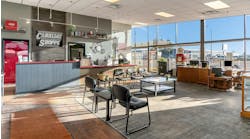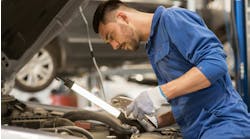Utilizing an outside salesperson isn’t a novel concept; Allen Billings has used one since the 1970s. However, he says it’s not only a position he still sees value in, but it’s also one that has evolved significantly in the past few years to becoming a full-time employee dedicated to the dealership.
“With outside sales reps, it can not only bring in new business but it strengthens our existing accounts,” he says. “We understand their needs, we want to listen to them to understand how we can improve service to them.”
At the three parts departments Billings oversees as part of the John Elway Group in Englewood, Colo., having an outside salesperson is crucial to building quality relationships and staying on top of those, particularly as the parts departments have inventories of $3.4 million and heavy wholesale numbers. Billings’ salesperson calls on several hundred active accounts and thousands total, meaning Billings has had to devise a foolproof strategy for having better sales calls. He breaks down his eight biggest tips that can work in any fixed ops department.
1) Utilize a full-time employee.
Billings recommends using a full-time employee versus a part-time independent contractor working for multiple clients. While Billings believes the line sheet contractors have their place, a dedicated employee is able to provide better service and spend more time working with specific issues tied to your dealership and clients.
The other advantage is what with each OEM running its own program, learning eight or nine different programs can be time consuming. By having a dedicated employee, Billings says they’re able to learn the ins and outs of your specific programs and become a true resource for your accounts.
2) Hire the right person.
At the end of the day, this is still a people business, Billings says, so it’s critical to hire an outside salesperson who is personable with good communication skills.
“A lot of times we’ll have vendors come in and we pretty much don’t want to talk to them. We require them to make an appt and sit and listen and try to move them on as quick as possible,” he says. “If it’s a person that comes in and we’re enjoying talking to them about their programs, that’s somebody we probably want to look at.”
Billings says he looks for people who take the time to answer questions, are eager and genuine about helping the dealership work through issues and problems, and who see themselves as partners.
3) Make sure they understand the message.
While the training process depends on the employee and his or her level of background knowledge of the automotive industry and the dealership operation, Billings says it’s still critical that the outside salesperson understand the ins and outs of the operations, the dealership’s core values and mission, and how each department works. Upon hiring a new outside salesperson, Billings will have the employee spend time in the store, meet all the salespeople and support staff and work with the wholesale parts team to truly understand the operation before going out and calling on accounts. He says that some OEMs are also very diligent about sending their own trainers out train outside sales staff.
4) Identify target markets.
While Billings doesn’t have a minimum number of accounts he requires the outside salesperson to call on per day—he preaches quality visits over quantity—he says he maximizes the sales person’s time by putting together a list of accounts in a geographic area. You don’t want the salesperson spending all day driving from one end of town to another, he says.
Billings does recommend seeing each account on a quarterly basis, and increasing that number if it’s a new account.
5) Make it a team effort.
Beyond working with the wholesale staff during the training period, Billings says it’s important that the wholesale staff supports the outside salesperson at all times. Your team has a wealth of knowledge, Billings says, and can help the salesperson set up routes, make suggestions, note accounts they’re having issues with, etc.
“They can tell if it’s an account that’s not giving us first shot on parts and he’ll go out and try to find out why and put together a presentation about why it would be better to buy from us,” he says.
6) Tailor the sales presentation.
No two accounts are alike, and the outside salesperson needs to keep that in mind when creating a sales presentation. The sales presentation should speak specifically to the account at hand, addressing their challenges, programs and needs. Billings recommends taking advantage of the sales sheets that various OEMs generate and allow dealerships to customize.
7) Track results.
While Billings doesn’t have specific benchmarks he uses for his outside salesperson, he does monitor all his sales calls using a program called PSX. Within that system, the salesperson inputs his daily contacts, who he talked to, what they talked about and the account’s purchases. Billings prints out a report every day and a weekly summary that goes to the general manager and owners. The reports also help the outside salesperson determine with which accounts they should be spending more time.
“With so many accounts that you’re trying to monitor, it’s easy to have them slow down purchasing or quit purchasing altogether and not say anything about it,” Billings says. “It’s a tool that helps us isolate those accounts and then talk to them.”
8) Provide meaningful help.
As the industry has changed over the years, so too has the outside salesperson position. With so many new programs utilized—like CollisionLink, ParsTrader and CCC ONE in collision and MARS and RepairLink on the mechanical side—Billings says the position has become more of a trainer, helping shops learn how to utilize and maximize the use of these programs, or training new employees on the functionalities.
Over the years, he’s also considered outside-the-box ways to maximize the value of the outside salesperson. One way he’s done so is by hosting powertrain and collision clinics three or four times per year. During those events, 40-60 clients will come in and a trainer will present on a variety of different subjects pertaining those clients, in addition to providing dinner and door prizes.



